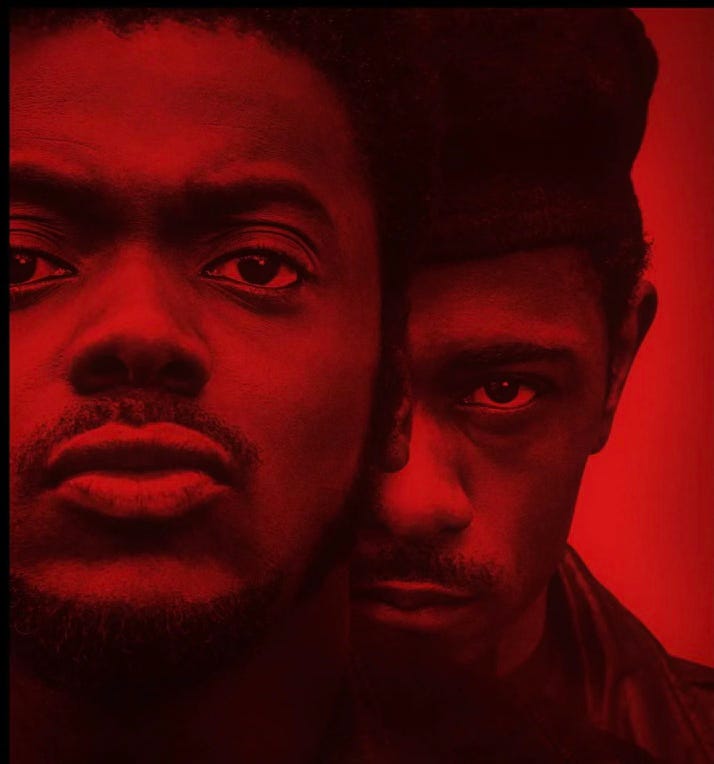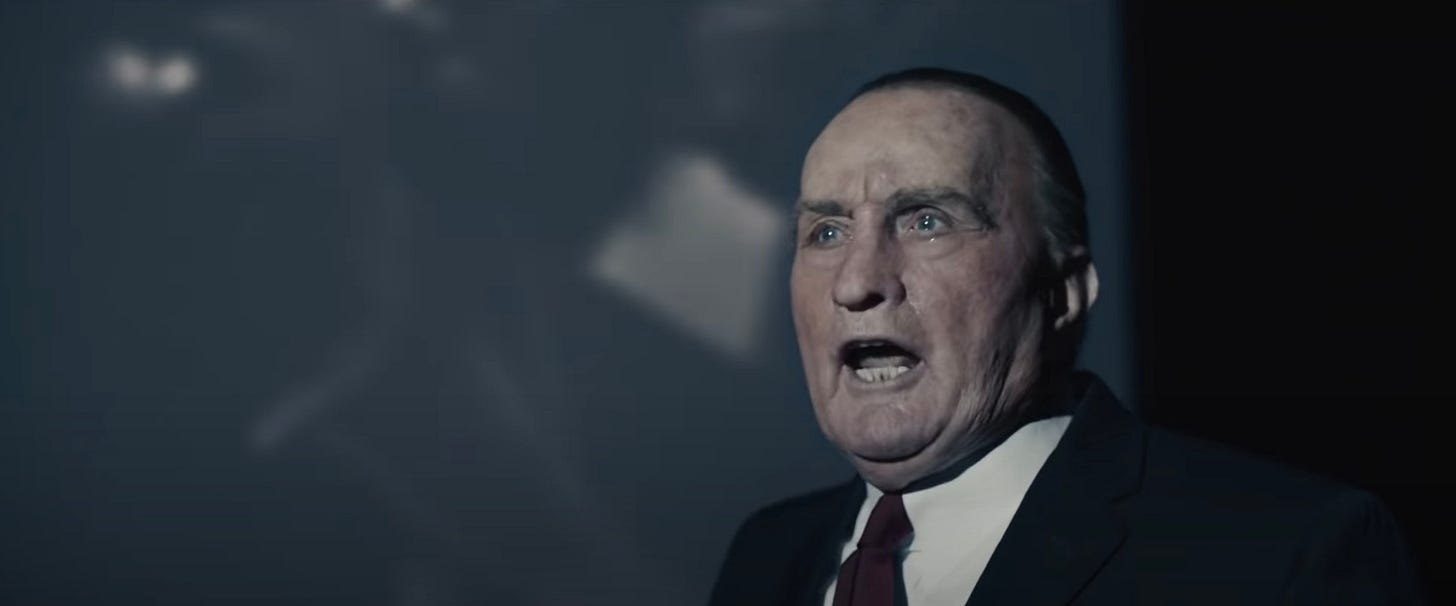Radical America and the False Messiah
Thoughts after seeing Shaka King's biopic of Fred Hampton
In the first few minutes of Judas and the Black Messiah, Martin Sheen delivers a speech as J. Edgar Hoover in which he warns about a coming “black messiah.”
The Black Panthers are the single greatest threat to our national security. More than the Chinese. Even more than the Russians. Our counter-intelligence program must prevent the rise of a black messiah from among their midst. One with the potential to unite the Communist, the anti-war, and the New Left movements.
He then draws the audience’s attention to a photograph of Fred Hampton and says Hampton is the threat he means. Director Shaka King paces the story like a thriller rather than a biographical drama, and it mostly pays off. I only say mostly because in its effort to cover Hampton’s rise, William O’Neal’s betrayal, and the FBI’s illegal surveillance tactics, the film occasionally rushes past key moments rather than fully unpack Hampton’s inner life or the political tensions within the Panther movement.
Still, King manages to honor Hampton without sanctifying him. He tells the story of personal betrayal involving O’Neal as the FBI informant who infiltrated the Black Panther Party and drugged Hampton on the night of his murder. This is clearly our Judas, who died a Judas death after an interview he gave about his informancy aired in 1990. But the film also addresses the deeper story of institutional betrayal and how the FBI went from guarding Americans while they sleep to shooting them in their beds.
Hampton sounds on the surface like he’d be at home among the pro-Hamas wokerati of your basic Columbia encampment, particularly given his love of talking about how capitalism is actually colonial white supremacy. But woke activists who claim him as one of their own may not know that he also famously said:
We don’t think you fight fire with fire best. We think you fight fire with water best. We’re going to fight racism not with racism. But we’re going to fight with solidarity.
If I had one nit to pick, it would be to say Hoover had it all wrong. The black messiah was never Hampton. To be sure, as a Marxist-Leninist and chairman of the Illinois chapter of the Black Panther Party, which explicitly embraced revolutionary socialism, Hampton was one of the key figures in American communism up until the night in 1969 when he was drugged by his friend O’Neal and shot twice in the head while unconscious by the FBI and Chicago police.
The movie does a decent job, I thought, of conveying the complexity of Hampton’s legacy as both a civil rights leader who believed in building alliances across racial lines — and an ideologue who idolized sociopaths such as Che Guevara and genocidal psychopaths such as Vladimir Lenin and Mao Zedong.
In his speeches, Hampton spoke in class-conscious terms, rejected capitalism as inherently racist and exploitative, and called for socialist revolution. He built coalitions with other Marxist groups, including white Appalachian organizers and Puerto Rican leftists, under the so-called Rainbow Coalition, which he founded in 1969 as a political alliance of radical groups across racial and ethnic lines, united by their shared opposition to poverty and the police.
In all, he was an incredibly gifted organizer. And yes, the anti-war movement respected him too. Hampton wasn’t primarily known as an anti-war leader, but he vocally opposed the Vietnam War and U.S. imperialism more broadly. He criticized the draft and saw the war as a tool of capitalist and white supremacist oppression. For many in the anti-war movement, especially those disillusioned with liberal reform, Hampton embodied a more militant and principled resistance. He drew direct connections between military aggression abroad and police violence at home.
Additionally, the New Left students looked up to him. His emphasis on grassroots organizing, political education, and coalition-building deeply resonated with their ideals of participatory democracy and radical transformation. Groups like Students for a Democratic Society (SDS) admired the Panthers’ ability to combine community programs with revolutionary theory. And this was his super power. Hampton, who was charismatic and young — only 21 when he was killed — was a natural bridge between urban black radicals and predominantly white campus activists. His message of unity across race and class struck a chord with many New Left students who were deeply frustrated with both liberalism and sectarianism.
So in a sense, yes, Fred Hampton was respected across ideological lines on the radical left because he embodied a rare combination of intellectual clarity, revolutionary commitment, and charismatic leadership. His ability to speak to black liberation, class struggle, anti-imperialism, and movement unity made him a figure whose appeal transcended differences between individual factions.
His assassination by the FBI and Chicago police only deepened his status as a martyr across all those movements. But despite the fact that Hampton operated under intense government surveillance and sabotage, particularly through the FBI’s COINTELPRO program, whereby the federal government actively worked to discredit and destroy black radical organizations, he was never going to be the black messiah Hoover feared and martyred.
For one thing, black political activism in the 1960s was too fragmented, with different groups like the Panthers and local grassroots movements often competing for resources and influence. Hampton was based in Chicago, and while he had influence across the Midwest, building a national infrastructure would have required more time and coordination. Even within Chicago, Hampton and the Chicago chapter of the Panthers faced conflicts with other groups such as the Vice Lords, Gangster Disciples, and the Nation of Islam.
Hampton’s genius was that rather than letting gang conflicts or ideological divisions tear the movement apart, he politicized the streets. He treated gangs as potential liberation forces, not enemies — if they could be brought into a revolutionary framework. This was highly unusual at the time and incredibly threatening to the establishment.
But his failure was his extremism. His militancy turned off many older blacks, who favored the nonviolent civil rights leadership of Martin Luther King Jr. or church-based movements. Hampton’s revolutionary rhetoric not only rejected the exploitation of capitalism, but Christianity’s pacifism and American patriotism too, thus alienating virtually the whole nation.
After U.S. troops withdrew from Vietnam in 1973 and the war officially ended in 1975, much of the anti-war movement lost its unifying cause and splintered into factions like the New Left, Students for a Democratic Society, and more radical groups such as the Weather Underground.
The culture of protest in America evolved from mass protest to issue-based activism such as nuclear disarmament, opposition to U.S. involvement in Nicaragua and El Salvador, and apartheid in South Africa. At the same time, the counterculture-to-NGO pipeline pulled many former activists into academia, nonprofits, or policy circles, channeling their ideals into institutional reform rather than mass protest.
In the end, the figure who most effectively united the Communist, anti-war, and New Left movements in the U.S. during the late 1960s was Angela Davis. Together, she, her mentor Herbert Marcuse, and Fred Hampton represent three distinct yet overlapping strands of 1960s radicalism: feminist communism, critical theory, and revolutionary black socialism. While many of their contemporaries were sidelined by history, these three figures remain central to the history of America’s radical past.





"Hampton’s legacy as both a civil rights leader who believed in building alliances across racial lines — "
This was true. I was one of those who reached across racial lines. I recall having breakfast with his team that fall and admiring their hands-on, practical work helping people in need.
"He built coalitions with other Marxist groups, including white Appalachian organizers and Puerto Rican leftists, under the so-called Rainbow Coalition, which he founded in 1969..."
My ties to him and the birth of the Rainbow Coalition were through Chicago Theological Seminary, an incubator for the Rainbow Coalition. (Think Jesse Jackson, and others.)
"For many in the anti-war movement, especially those disillusioned with liberal reform, Hampton embodied a more militant and principled resistance."
True.
"His assassination by the FBI and Chicago police only deepened his status as a martyr across all those movements."
Most people do not understand another factor in the "police attack." I went to CTS during the day, worked at Mercy Hospital overnight. One night, as an orderly, I wheeled a police officer from ER to Radiology and back. He had been shot in hand and foot. His partner, who stood in front of him, was killed by the shotgun blast that came when they knocked on a door. My personal conversation with the officer was heartbreaking. He had no idea of the politics driving unrest. The police thought the shooting was tied to the Black Panthers. (I doubt that.) But the murder of Hampton (a couple nights later) was at least partially retribution for the murder of the police officer whose partner I met that night.
"Even within Chicago, Hampton and the Chicago chapter of the Panthers faced conflicts with other groups such as the Vice Lords, Gangster Disciples, and the Nation of Islam."
Not entirely accurate. There were other groups. The gangs were the Conservative Vice Lords, the Disciples, and the Black P Stone Nation. Hampton, as far as I know, was not in conflict with the gangs.
"Hampton’s genius was that rather than letting gang conflicts or ideological divisions tear the movement apart, he politicized the streets. He treated gangs as potential liberation forces, not enemies — if they could be brought into a revolutionary framework. This was highly unusual at the time and incredibly threatening to the establishment."
Absolutely. Later, I worked as a trainer for the Street Academy Program, with the Chicago group. It was a storefront school program where young people could get their GED. In my work, I discovered the (hidden) involvement of the major Chicago gangs. One evening four of us drove around Chicago together, discussing the scene. A member of the leadership of each of the three gangs and a white guy. These older leaders (each gang had a leadership team of 21) were intent on organizing the youth into a political movement. They were staunchly opposed by Chicago politicians. (And, I discovered, by the Feds.) The Feds came to our base camp in New Mexico to have a talk with me... I was instructed to give them the names of the people in the program who should be let go and those who should stay. I refused, as that was not our agreement with the trainees. They fired me on the spot. (I later figured out they wanted me to rat out the gang members.) Chicago politics to this day reflects the failure of those principled and brave young men who saw a better future for the youth of Chicago.